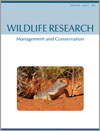Context . Wildlife crossing structures are installed to mitigate the impacts of roads on animal populations, yet little is known about some aspects of their success. Many studies have monitored the use of structures by wildlife, but studies that also incorporate individual identification methods can offer additional insights into their effectiveness.
Aims . We monitored the use of wildlife crossing structures by arboreal marsupials along the Hume Freeway in south-eastern Australia to (1) determine the species using these structures and their frequency of crossing, (2) determine the number and demographic characteristics of individuals crossing, and (3) use the rate of crossing by individuals to infer the types of movement that occurred.
Methods . We used motion-triggered cameras to monitor five canopy bridges and 15 glider pole arrays installed at 13 sites along the Hume Freeway. The five canopy bridges were also monitored with passive integrated transponder (PIT)-tag readers to identify the rate of use by individuals.
Key results . Five species of arboreal marsupial were detected using canopy bridges and glider poles at 11 sites. Our analysis suggested that increasing the number and the distance between poles in a glider pole array reduced the rate of use by squirrel gliders. The PIT tag and camera footage revealed that the structures were used by adult males, adult females and juveniles, suggesting that all demographic groups are capable of using canopy bridges and glider poles. At two canopy bridges, multiple squirrel gliders and common brushtail possums crossed more than once per night.
Conclusions . Given that previous studies have shown that the freeway is a barrier to movement, and that many of the species detected crossing are subject to road mortality, we conclude that canopy bridges and glider poles benefit arboreal marsupials by providing safe access to resources that would otherwise be inaccessible.
Implications . Although the factors influencing crossing rate require further study, our analysis suggests that glider pole arrays with fewer poles placed closer together are likely to be more successful for squirrel gliders. The individual identification methods applied here offer insights that are not possible from measuring the rate of use alone and should be adopted in future monitoring studies.





